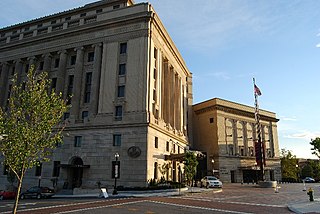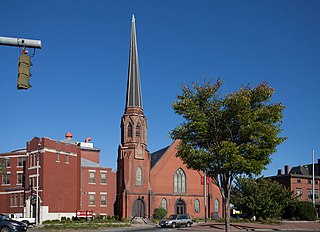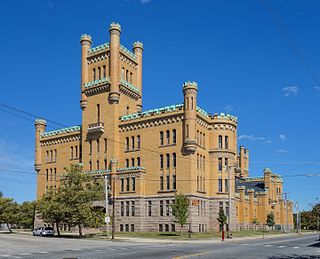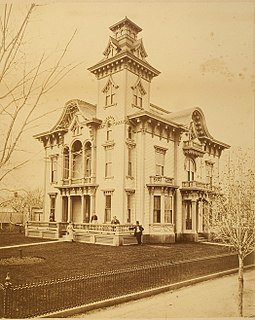
College Hill is a neighborhood in Providence, Rhode Island, and one of six neighborhoods comprising the East Side of Providence and part of the College Hill Historic District. It is roughly bounded by South and North Main Street to the west, Power Street to the south, Governor Street and Arlington Avenue to the east and Olney Street to the north. College Hill is also home to Thayer Street, a shopping strip frequented by students in the Providence area.

Veterans Memorial Auditorium is a performing arts theater in Providence, Rhode Island. Construction began in 1928 but was delayed by the Great Depression. The theater was finally completed in 1950. The adjacent Performing Arts Complex was erected in 1970 and is partially owned by the Veterans' Memorial Foundation.

Elmwood is a neighborhood in the South Side of Providence, Rhode Island. The triangular region is demarcated by Broad Street, Elmwood Avenue, and Interstate 95.

This is a list of the National Register of Historic Places listings in Providence, Rhode Island.

The Esek Hopkins House is an historic home on 97 Admiral Street on the north side of Providence, Rhode Island, United States.

The Governor William Sprague Mansion is an historic mansion and museum at 1351 Cranston Street in Cranston, Rhode Island. The house was the birthplace of Governor William Sprague III and his nephew, Governor William Sprague IV.

The America Street School was an historic school at 22 America Street in Providence, Rhode Island. The school was a two-story brick structure, built in 1905 to a design by Frederick E. Field. It housed ten classrooms, and was one of four similarly-sized schools built by the city between 1887 and 1916. The building served the city as a school until 1955, and was used for a time thereafter as a meeting place for a local branch of the Veterans of Foreign Wars.

The Brick Schoolhouse is a historic colonial meeting house and school at 24 Meeting Street in the College Hill neighborhood of Providence, Rhode Island.

Christ Episcopal Church was an historic Episcopal church at 909 Eddy Street in Providence, Rhode Island.

The Covell Street School is an historic school building at 231 Amherst Street in Providence, Rhode Island. It is a two-story wood frame structure built in a typically elaborate Queen Anne style. Although it is basically rectangular in plan, its roofline and exterior are busy, with a complicated group of cross gables, hip-roof sections, with projecting and recessed sections. A three-story square tower rises from the center of the main facade. Built in 1885 and opened in 1886, it is one of Providence's last surviving 19th-century neighborhood school buildings. It was designed by the local firm of William R. Walker & Son, designers of many Rhode Island civic buildings. The builders were John L. Sprague & Company.

The Joseph Haile House is an historic house in the College Hill neighborhood of Providence, Rhode Island. It is a 3-1/2 story brick structure, appearing taller than that due to its hillside location and raised basement. It is a well-preserved example of Federal styling, which underwent a careful restoration in the 1930s by George Warren Gardner, who filled the house with early American furniture. The Gardners bequested the property to Brown University, which uses it to house visiting dignitaries.

Louttit Laundry was at one time the largest laundry business in Rhode Island, with 150 employees and 16 outlets throughout the state. Their historic building at 93 Cranston Street was on the National Register of Historic Places. The company was sold in 1985 and closed in 1987. The Cranston Street building was built in 1906, expanded in 1925, damaged by fire in 2001, and demolished in 2008.

The Market House is an historic three-story brick market house in Market Square, in the College Hill neighborhood of Providence, Rhode Island, USA. The building was constructed in 1775 to a design by locally prominent architect Joseph Brown and Declaration of Independence signer Stephen Hopkins. The bottom level of the structure was used as a market and the upper level was used for holding meetings in the tradition of English public market buildings. Similar buildings existed in other American cities, such as Faneuil Hall in Boston and the Old Brick Market in Newport. The building housed the Providence City Council in the decades before completion of City Hall.

The Perkins Buildings are a group of three historic industrial buildings located at 85 Sprague Street, 101 and 102 Westfield Street in Providence, Rhode Island. They were built between 1887 and 1892 by Charles H. Perkins, and were originally occupied by separate industrial tenants. Two of the buildings are brick structures built in 1892 and 1890, respectively, while the 1887 mill at 101 Westfield is a wood-frame structure, a rare 19th-century survivor in the state. These buildings were consolidated into a single industrial complex in the first half of the 20th century by the Rau Fastener Company, which operated on the premises until 1994.

The Providence Jewelry Manufacturing Historic District is a predominantly industrial historic district in Providence, Rhode Island. It covers a roughly 19-acre (7.7 ha) area just south of Downtown Providence, and was originally bounded by Interstate 195 prior to a realignment in the 2000s which reconnected the two areas. Although the area began as a residential area, and still has some houses in it, it developed in the late 19th and early 20th centuries as a center of Providence's jewelry manufacturing businesses. The oldest industrial building in the district is the 1848 Elm Street Machine Shop, a 2 1⁄2-story stone structure that now houses offices of Brown University.

Temple Beth-El, formerly known as the Broad Street Synagogue, is a historic Jewish synagogue at 688 Broad Street in Providence, Rhode Island.

The Trinity Square Historic District is a historic district in the Elmwood neighborhood of Providence, Rhode Island. It includes four properties on the south and west side of Trinity Square, the triangular junction of Elmwood Avenue and Broad Street. The visual focal points of the district are the Grace Church Cemetery, which is located south of the square, and the Trinity United Methodist Church, an imposing Gothic Revival structure built in the mid-1860s to a design by Clifton A. Hall. North of the church stands the Clifton Hall Duplex, designed and occupied by Hall, and the James Potter House, an elaborate Queen Anne mansion built c. 1889 and designed by Stone, Carpenter & Willson.

The Cranston Street Armory is an historic building in the Broadway–Armory Historic District of Providence, Rhode Island. It was built in 1907 at a cost of $650,000.00. The building was occupied by the Rhode Island National Guard from its opening until 1996. Since then, parts of the building have been used as film studios, and some of its offices occupied by the Rhode Island State Fire Marshal. The National Trust for Historic Preservation listed the Armory as one of "America's 11 Most Endangered Historic Places" in its annual list for 1997. Its distinctive yellow bricks, crenellated turrets, and decorative stonework mark it as a historically significant building and neighborhood icon.
Antoinette Forrester Downing was an architectural historian and preservationist who authored the standard reference work on historical houses in Rhode Island. She is credited with spearheading a movement that saved many of Providence's historic buildings from demolition in the mid 20th century and for her leadership was inducted into the Rhode Island Heritage Hall of Fame in 1978.

The Wedding Cake House, is a three-story historic house located at 514 Broadway Street in the Broadway-Armory Historic District of Providence, Rhode Island. Built in 1867 and occupied continuously until 1989, its contents were the subject of a 2001 exhibit at the Rhode Island School of Design Museum. It has had a variety of restoration work conducted since 2011.





















